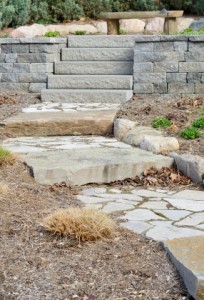 Although a beautiful landscape may not be easy to create, almost everyone recognizes one. A perfectly green lawn, full shrubs, majestic trees and gorgeous flowers are among the pretty plantings that most people would think of as part of an attractive landscape. However, maintaining that beauty comes at an environmental price that just isn’t compatible with the green way more and more people are attempting to live today. The large amounts of water and fertilizer that often go into lush landscapes are an environmental nightmare. Now people who want a fabulous landscape without the environmental impact are turning to drought-resistant landscaping.
Although a beautiful landscape may not be easy to create, almost everyone recognizes one. A perfectly green lawn, full shrubs, majestic trees and gorgeous flowers are among the pretty plantings that most people would think of as part of an attractive landscape. However, maintaining that beauty comes at an environmental price that just isn’t compatible with the green way more and more people are attempting to live today. The large amounts of water and fertilizer that often go into lush landscapes are an environmental nightmare. Now people who want a fabulous landscape without the environmental impact are turning to drought-resistant landscaping.
While drought-resistant gardening involves a variety of practices, the main idea is to design a pleasant landscape that uses the least amount of resources. Since Bryan-College Station sets the eco-friendly landscaping trends in the region, you might want to consider ways to make your landscaping more drought-resistant. In the end, not only will the overall environment benefit, but you’ll save money, too. To get you started, we have a few suggestions.
First, select native plants. Plants that are native to the Bryan-College Station area are accustomed to our dry climate and thrive here naturally. From the fragrant, grayish green Artimisia to the lovely purple spires of salvia to the sunny yellow blooms of Rudbeckia (better known as Black-eyed Susan) the local diversity in indigenous plants makes selecting your favorites the hardest part about native planting. Their ability to flourish in drought means that you will save water as well as the money spent on it.
Then consider plant maintenance. While fertilizers are the usual route, these chemicals can be potentially unsafe for children and pets as they play on the lawn or come in contact with plants that have been sprayed. Plus, fertilizers can be hazardous to waterways as the runoff from streets enters the waters and harms fish. The more sustainable way to maintain your plants is through organic gardening. Creating a compost pile to nourish your plants and using plain boiling water on weeds are both environmentally-friendly alternatives to chemical fertilizers.
Another aspect of drought-resistant landscaping to keep in mind is the hardscape. Patios, paths, arbors, retaining walls and any other hard surface in landscaping is part of the hardscape. One of the best ways to incorporate these areas into a drought-resistant landscaping design is through the use of recycled elements. Provide a second life for old items you already have that are made of lumber, brick, stone, concrete or metal by using them in new, innovative ways. An old bench, for instance, can be recycled as a planter just as old bricks make a lovely path. Think outside the usual. Be unafraid to ask for discarded materials at renovation sites of old buildings and homes. These places can be a treasure trove of useful material for your hardscape.
While not an exhaustive list of drought-resistant landscaping ideas, these suggestions will help you make a very good beginning. Then, if you decide that you need a bit more help, contact ABC Home & Commercial Services in Bryan and College Station, or request a free estimate through our website. We’re happy to help you make your drought-resistant gardening dreams come true.